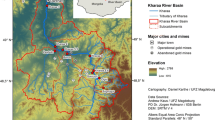Abstract
Metals that originate from coal-combustion residue (ash) deposited in water-filled lagoons are eventually released into the environment. This study measured metal concentrations in sediment and fish obtained in the vicinity of two coal-combustion ash-lagoon outfalls on the East River (Nova Scotia) and Grand Lake (New Brunswick), Canada. Of the 34 metals analysed, this study demonstrated that sediment in the immediate vicinity of the ash lagoon discharge in New Brunswick had statistically significant greater concentrations of thallium, arsenic, and antimony than did the sediment obtained from background areas. Tissue arsenic concentrations were increased in fish obtained near the lagoon discharge in New Brunswick but not statistically greater than that of fish obtained from background areas. Neither sediment nor fish obtained near the ash-lagoon discharge in Nova Scotia had significantly greater concentrations of any of the metals measured.



Similar content being viewed by others
References
Alberts JJ, Newman MC, Evans DW (1985) Seasonal variations of trace elements in dissolved and suspended loads for coal ash ponds and pond effluents. Water Air Soil Pollut 26:111–128
Canadian Council of Ministers of the Environment (2001) Canadian sediment quality guidelines for the protection of aquatic life: Introduction. Updated. In: Canadian environmental quality guidelines, 1999, Canadian Council of Ministers of the Environment, Winnipeg, MB, Canada
Canadian Food Inspection Agency (2005) Canadian guidelines for chemical contaminants and toxins in fish and fish products.
CEM MARS5 Microwave instructions (2009) http://bowdoin.info/chemistry/instrumentation/instructions/pdf/cem-mars5-microwave-8-09.pdf. Accessed 1 December 2010
Cumbie PM, VanHorn SL (1978) Belews Lake environmental study report: selenium and arsenic accumulation. Tech. Report 78–04. Duke Power Co., Charlotte, NC
Dale JM, Freedman B (1982) Arsenic pollution associated with tailings at an abandoned gold mine in Halifax County, Nova Scotia. Proc NS Inst Sci 32:337–349
Dvorak AJ, Lewis BJ, Chee PC, Freeman RF, Dettmann HC (1978) Impacts of coal–fired power plants on fish, wildlife and their habitats. FWS/OBS-79/29. US Department of Fish and Wildlife
ENVIRODAT (2010) Internet database of Canadian environmental quality data. http://map.ns.ec.gc.ca/envirodat/root/main/en/main_e.asp. Accessed: April 30, 2010
Environment Canada (1979) Coal and the inland water environment of Atlantic Canada. Inland Waters Directorate, Atlantic Region
Furr AK, Parkinson TF, Youngs WD, Berg CO, Gutenmann WH, Pakkala IS et al (1979) Elemental content of aquatic organisms inhabiting a pond contaminated with coal fly ash. NY Fish Game J 26:154–161
Garrett GP, Inman CR (1984) Selenium-induced changes in fish populations in a heated reservoir. Proc Annu Conf Southeast Assoc Fish Wildl A 38:291–301
Hatcher CO, Ogawa RE, Poe TP, French JRP (1992) Trace elements in lake sediment, macrozoobenthos, and fish near a coal ash disposal basin. J Fresh Ecol 7(3):257–269
Hopkins WA (2001) Effects of coal combustion wastes on survival, physiology, and performance of the benthic-feeding fish, Erimyzon sucetta, Doctoral dissertation. University of South Carolina, Columbia, SC
Hopkins WA, Rowe CL, Congdon JD (1999) Elevated trace element concentrations and standard metabolic rate in banded water snakes (Nerodia fasciata) exposed to coal combustion wastes. Environ Toxicol Chem 18:1258–1263
Huggins FE, Constance LS, Chu P, Ladwig K, Huffman GP (2007) Selenium and arsenic speciation in fly ash from full scale coal burning utility plants. Environ Sci Technol 41(9):3284–3289
Jaagumagi R (1990) Development of the Ontario provincial sediment quality guidelines for arsenic, cadmium, chromium, copper, iron, lead, manganese, mercury, nickel and zinc. Water resources branch. Ontario Ministry of the Environment, Toronto, ON
Jezierska B, Witeska M (2006) The metal uptake and accumulation in fish living in polluted waters. Soil Water Poll Monit, Prot Remediat 69:107–114
Leger A (1991) Environmental concentrations of arsenic in Atlantic Canada. Inland Waters Directorate, Atlantic Region. Environment Canada. IWD-AR-WQB-91-169
Lemly AD (1997) Ecosystem recovery following selenium contamination in a freshwater reservoir. Ecotoxicol Environ Safe 36:275–281
Lohner TW, Reash RJ (1999) Assessment of bioindicator applications at selected AEP wastewater receiving streams and biomarker studies on fish from AEP wastewater receiving streams. AEP Research Project Report # 6902 and 6913. American Electric Power, Columbus, OH
McGrawth PE (2005) Site fidelity, home range and daily movements of white perch, Morone Americana, and stripped bass, Morone saxatilis, in two small tributaries of the York River, Virginia. Thesis Presented to the Faculty of the School of Marine Science, The College of William and Mary, Williamsburg, VA
Narukawa T, Takatsu A, Chiba K, Riley KW, French DH (2005) Investigation on chemical species of arsenic, selenium and antimony in fly ash from coal fuel thermal power stations. J Environ Monit 7:1342–1348
Olmsted LL, Degan DJ, Carter JS, Cumbie PM (1986) Ash basin effluents as a concern of fisheries managers: a case history and perspective. In: Hall GE, Van Den Avyle MJ (eds) Reservoir fisheries management: strategies for the 80’s. American Fish Socciety, Bethesda, MD, pp
Panagapko D (2006) Mineral and metals commodity reviews [under Cement]. Natural Resources Canada, Minerals and Metals Sector. http://www.nrcan-rncan.gc.ca/mms-smm/busi-indu/cmy-amc/content/2006/17.pdf
Reash RJ, Lohner TW, Wood KV, Willet VE (1999) Ecotoxicological assessment of bluegill sunfish inhabiting a selenium-enriched fly ash stream. In: Henshel DS, Black MC, Harras MC (eds) Environmental toxicology and risk assessment (STP 1364) vol 8. American Society for Testing and Materials, West Conshohocken, PA
Rowe CL (2003) Growth responses of an estuarine fish exposed to mixed trace elements in sediments over a full life cycle. Ecotox Environ Safe 54(2):229–239
Rowe CL, Kinney OM, Fiori AP, Congdon JD (1996) Oral deformities in tadpoles (Rana catesbeiana) associated with coal ash deposition: effects on grazing ability and growth. Freshw Biol 36:723–730
Rowe CL, Hopkins WA, Congdon JD (2002) Ecotoxicological implications of aquatic disposal of coal combustion residues in the United States: a review. Environ Monit Assess 80:207–276
Scott WB, Crossman EJ (1973) Freshwater fishes of Canada. Fisheries Research Board of Canada, Ottawa
Snodgrass JW, Hopkins WA, Broughton J, Gwinn D, Baionno JA, Burger J (2004) Species specific responses of developing anurans to coal combustion wastes. Aquat Toxicol 66:171–182
Sorensen EMB (1988) Selenium accumulation, reproductive status, and histopathological changes in environmentally exposed redear sunfish. Arch Toxicol 61:324–329
TetraTech Inc (1986) Development of sediment quality values for Puget Sound. vol 1. TetraTech Inc., Bellevue, WA
United States Environmental Protection Agency (1989) USEPA method study 37 SW-846 Method 3050 Acid digestion of sediments, sludges, and soils. EPA/600/S4-89/012. Environmental Monitoring systems Laboratory, Cincinnati, OH
United States Environmental Protection Agency (1998) Method 7473. Mercury in solids and solutions by thermal decomposition, amalgamation, and atomic absorption spectrophotometry. http://www.epa.gov/epawaste/hazard/testmethods/sw846/pdfs/7473.pdf
University of New Brunswick (2007) Inland fish species of New Brunswick. http://www.unb.ca/cri/. Accessed: April 30, 2010
Acknowledgments
Many thanks to Environment Canada’s Environmental Quality Laboratory in Moncton (NB) for providing the fish tissue preparation and analysis. Thanks to Karen Kidd and Angella Mercer from the Canadian Rivers Institute for their diligent measurement of mercury in fish tissues.
Author information
Authors and Affiliations
Corresponding author
Rights and permissions
About this article
Cite this article
Lalonde, B.A., Ernst, W. & Comeau, F. Trace Metal Concentrations in Sediments and Fish in the Vicinity of Ash Lagoon Discharges from Coal-Combustion Plants in New Brunswick and Nova Scotia, Canada. Arch Environ Contam Toxicol 61, 472–481 (2011). https://doi.org/10.1007/s00244-010-9632-0
Received:
Accepted:
Published:
Issue Date:
DOI: https://doi.org/10.1007/s00244-010-9632-0




